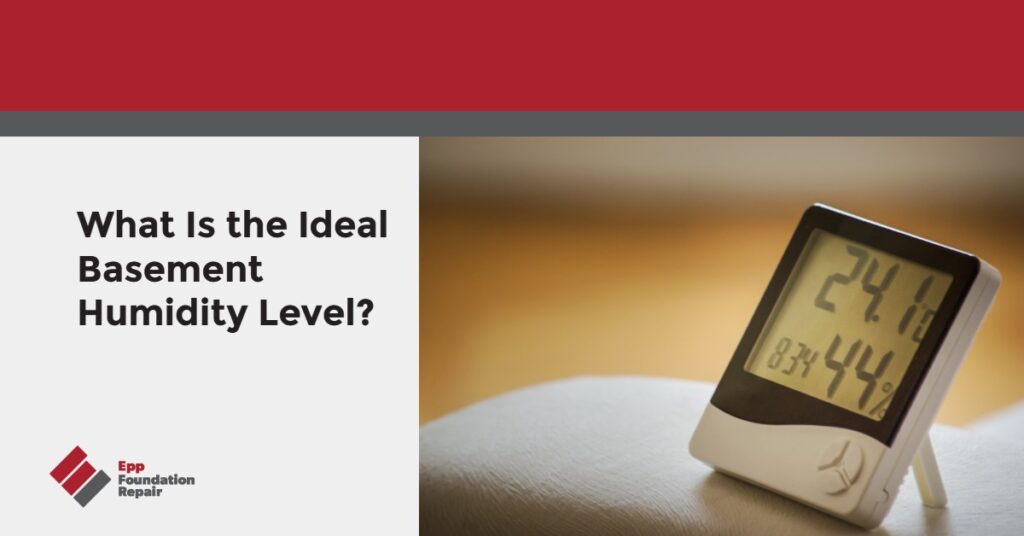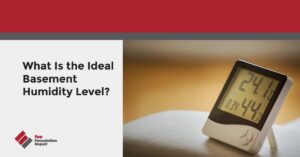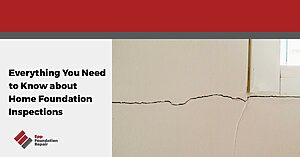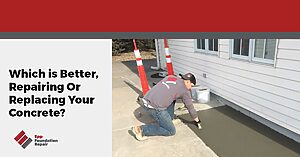Are you looking for information regarding the ideal basement humidity level? If so, stick around because this article covers what you need to know about ideal basement humidity.
Basements tend to be more humid than the rest of the house because they’re surrounded by soil. Since increased humidity promotes mold and mildew growth, homeowners should try to keep their home’s basement at an ideal basement humidity level.
What Is the Ideal Basement Humidity Level?
A humidity level over 50% will encourage mold growth. So, if you’re wondering if 60% humidity is too high for a basement, yeah, it is. The ideal basement humidity shouldn’t go over 50%.
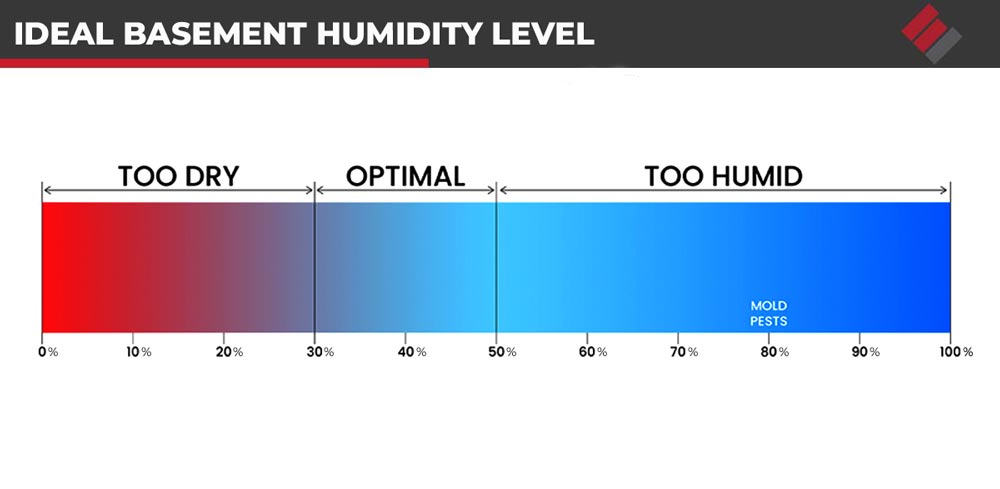
During the Summer
The outside air is warm and more humid during the summer than during other seasons. When this air flows into the basement, the humidity level could rise enough to cause mold growth. Many homeowners use a dehumidifier to keep the basement humidity level between 30 and 50% during the summer.
During the Winter
Because the outside humidity level is lower during the winter, the ideal basement humidity level will also be lower. Between 25 and 40% if you live in an area where the winter temperature often drops below 20F.
Why Are Basements Humid?
Basements are humid for various reasons, including:
- Basements are humid because they’re surrounded by soil – If there’s excess water in the soil and poor drainage, hydrostatic pressure will build up and press against the foundation wall with enough force to push water through invisible cracks in the foundation. Hydrostatic pressure can even cause foundation walls to crack and bow inward, affecting your home’s structural integrity. For more information, see Is Hydrostatic Pressure The Reason You Have a Wet Basement?
- You’re doing something in the basement that creates humidity – Examples of this include operating an unvented clothes dryer, cooking, using a shower, etc.
- Humid, warmer air flows in from outside and condenses on colder surfaces – This could look like water coming through the foundation wall, but it’s just condensation.
- Moisture from new concrete – In new homes, moisture can come from the concrete itself because there’s always a certain amount of moisture in freshly poured concrete.
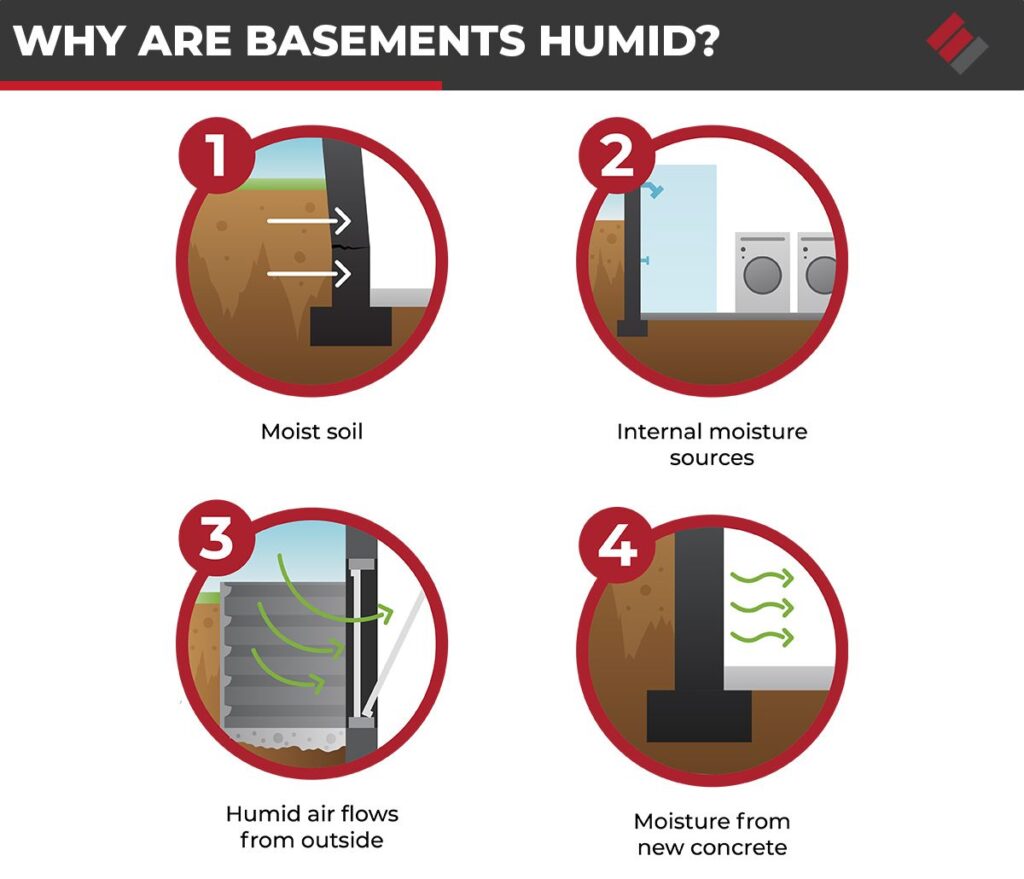
Why You Don’t Want a Humid Basement
You don’t want a humid basement because humid basements are a petri dish for mold and mildew and some of the air in the basement flows up and into the rest of your home. That means potential respiratory problems for anyone living in the home as they inhale various allergens.
Damp, humid basements also can’t be used as living spaces. Damp basements are also not a good place to store anything valuable. The most you can do with a damp basement is use it as a laundry room.
Finally, a damp, humid basement lowers your property value.
Signs of a High Basement Humidity Level
Signs your home’s basement might be more humid than it should be include:
- There’s water coming through one or more foundation walls – This is a sign of excess water in the soil outside the foundation wall, poor drainage, and a build-up of hydrostatic pressure. Water is being pushed through the foundation wall and into the basement.
- The basement walls feel damp – This might be from excess moisture outside the foundation wall or condensation.
- There’s standing water in the basement – This is an obvious sign something is wrong.
- There’s a ring of dampness around the base of the basement wall – Water is being drawn up through the concrete via capillary suction.
- The basement feels humid – If it feels humid, it probably is humid. Have you used a hygrometer to test the basement humidity level?
- There’s condensation on basement walls, floor, and other surfaces during the summer – This happens when the warmer outside air flows in and comes into contact with colder basement surfaces.
- There’s a musty smell in the basement.
- Carpet or wood structures in the basement are moldy and/or deteriorating.
- There’s efflorescence on the walls or floor – Efflorescence is salt deposits left behind after water intrusion. It has a chalky appearance.
- There are water stains on the walls or floor.
How to Lower Basement Humidity
Use a Dehumidifier And/or Air Conditioner During the Summer
If the problem is happening during the summer, the solution is to make sure the warmer, more humid air can’t enter the basement during the summer. You could do this by closing the windows and running a dehumidifier. (You could also run an air conditioner. However, a dehumidifier works best for dehumidification and it works for the entire house.)
Crack the Windows During the Winter
During the winter, when the air is colder outside, you could do the opposite. Crack the windows to allow fresh, dry air to enter the basement.
Use Vents and Exhaust Fans
How you lower the basement humidity level depends on what’s causing the excess humidity. If an unvented clothes dryer or a shower is causing the increased humidity level, the solution is to vent the dryer or install an exhaust fan in the shower.
Install a Drain Tile System
If your basement is humid because there’s poor drainage around your foundation and hydrostatic pressure is pushing water through the foundation wall, there’s only one truly effective solution: a drain tile system.
How a Drain Tile System Works
A drain tile system works by preventing excess water from building up in the soil around the foundation. There are two types of drain tile systems: exterior and interior. The exterior drain tile system is installed along the perimeter of the foundation wall at the footing level, while the interior drain tile system is installed under the basement floor. Both involve using a buried perforated pipe to channel excess moisture toward a sump pit, where it’s ejected away from the foundation via a sump pump.
A drain tile system is not a DIY project. An exterior drain tile system involves excavation down to the footer level, and an interior drain tile system requires using a jackhammer to break up the basement floor. Most people hire a foundation repair contractor to install a drain tile system. For more information, see How Does A Drain Tile System Work?
Other Ways to Lower the Humidity Level in Your Basement
If the high humidity level in your basement is being caused by excess groundwater around the foundation and poor drainage, there are a few other things you can do in addition to adding a drain tile system:
- Clean your gutters regularly, so water doesn’t spill over the side of your home and into the soil next to the foundation
- If your downspouts are releasing water next to the foundation, install extensions that will carry the water at least 10 feet from the foundation before releasing it.
- Your yard should slope away from the foundation. If it doesn’t, regrade it. A landscaping professional can help you with this.
- Don’t plant water-hungry vegetation next to the foundation. You don’t want a reason to add water to the soil around the foundation.

